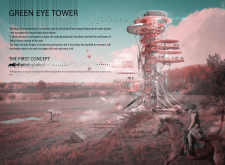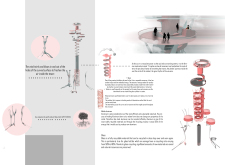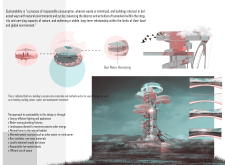5 key facts about this project
At first glance, the project reveals a clean, geometric form characterized by an intricate arrangement of volumes that invite exploration and interaction. The exterior façade is carefully articulated, with the use of various materials that work in synergy to create a cohesive visual narrative. Predominant materials include concrete, glass, and wood, each selected not only for their structural properties but also for their ability to resonate with the intended environmental context. Concrete serves as a robust framework, providing durability and strength, while expansive glass elements allow for an abundance of natural light, seamlessly merging indoor and outdoor spaces. The inclusion of wood introduces warmth, contrasting with the more industrial tones of concrete and glass, which softens the overall appearance and enhances user comfort.
The design prioritizes functionality, with a layout that is intuitive and easily navigable. Open spaces are interspersed with private areas, providing opportunities for both individual contemplation and communal gathering. This strategic arrangement reflects a deep understanding of user experience, ensuring that each area serves a distinct purpose while maintaining connection to the larger whole. The architectural plans demonstrate a careful consideration of flow, leading users through a journey that is both engaging and practical.
Unique design approaches have been employed to address sustainability and ecological awareness. The project integrates green building practices that minimize environmental impact, such as the incorporation of energy-efficient systems and the implementation of rainwater harvesting mechanisms. Thoughtful landscaping is another essential aspect, as indigenous plant species are utilized to promote biodiversity and reduce irrigation demands, further aligning the project with principles of environmental stewardship.
Incorporating advanced technologies, such as smart building systems, enhances the user experience by providing convenience and efficiency. These technologies operate quietly in the background, facilitating day-to-day operations without intruding on the spatial experience. The thoughtful integration of such innovations demonstrates a forward-thinking approach to architecture and design, emphasizing that modern buildings must adapt to the evolving needs of their users.
In examining architectural sections, one can observe how the design accommodates varying levels, allowing for both dynamic use of space and visual interest. This segmentation not only enhances natural light penetration but also creates distinct atmospheres as one moves between areas. The interplay of light and shadow on the surfaces adds a tactile quality to the experience, making the building feel alive throughout different times of the day.
Beyond its physical attributes, this project holds significant cultural importance. It serves as a gathering space for the community, fostering social interaction and engagement. By prioritizing public spaces, the design reflects a commitment to community-oriented architecture that elevates the daily lives of its users and instills a sense of belonging. The architecture is not merely a backdrop; it is an active participant in the lives of those who inhabit it.
Overall, this architectural design project stands as a testament to the possibilities inherent in modern architecture. Its skillful blend of materiality, thoughtful planning, and innovative practices culminates in a space that is functional, environmentally responsible, and deeply connected to its community. For readers interested in delving deeper into this project, exploring the architectural plans, architectural sections, and broader architectural ideas will yield valuable insights into the intricacies of the design. This exploration can provide a fuller understanding of how the project achieves its objectives while contributing meaningfully to the architectural landscape.


























